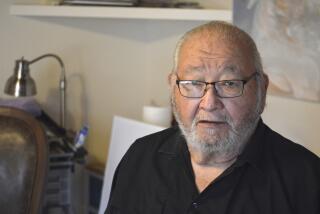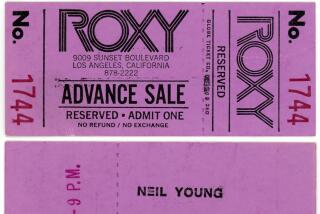Alan Lomax, 87; Preserved World’s Musical Heritage
Alan Lomax, the celebrated folklorist and musicologist whose collections of thousands of recordings of folk, jazz and blues musicians since the 1930s helped preserve America’s and the world’s heritage, died Friday at a hospital in Safety Harbor, Fla. He was 87.
The cause of death was not reported but Lomax suffered two strokes in 1995. He moved to the Tampa area in 1996 from his longtime home in New York.
He was the son of folklorist John A. Lomax, whose 1910 book “Cowboy Songs and Other Frontier Ballads” was a pioneering work in the field of music preservation. Among the famous songs it saved for posterity was “Home on the Range.”
Among the famous musicians the Lomaxes were the first to record were iconic figures such as Woody Guthrie, Huddie Ledbetter, later known as Leadbelly, and Muddy Waters.
They discovered Ledbetter on a prison farm in Louisiana and when his recording of “Goodnight, Irene” was released, it started the nation’s folk music revival.
His influence extends to contemporary artists such as the electronica star Moby, whose tracks have incorporated excerpts from Lomax’s field recordings of folk and blues music. Two songs from his collection were featured on the 2002 Grammy-winning soundtrack of “O Brother, Where Art Thou?”
Alan Lomax was still in his teens when he began assisting his father in efforts to interview and record musicians of almost every stripe.
Long before tape recording became feasible, the work entailed lugging around recording equipment that weighed hundreds of pounds.
Lomax said making it possible to record and play back music in remote areas “gave a voice to the voiceless” and “put neglected cultures and silenced people into the communications chain.”
Much of their work was done for the Library of Congress, where the Archive of American Folk Song had been established in 1928.
Some of the music that seemed exotic in the 1930s had a profound influence on the development of rock ‘n’ roll. In “The Rolling Stone Illustrated History of Rock & Roll,” critic Robert Palmer wrote about a black religious “ring shout” song, “Run Old Jeremiah,” recorded by the Lomaxes in a tiny rural church in 1934.
“The rhythmic singing, the hard-driving beat, the bluesy melody and the improvised, stream-of-consciousness words of this particular shout ... all anticipate key aspects of rock & roll as it would emerge some 20 years later,” Palmer wrote.
As interest in folklore and minority groups’ culture has grown in recent decades, experts and fans alike have been able to draw upon the recordings made so long ago.
When interest in Cajun music and its cousin, zydeco, exploded in the 1980s, for example, a two-album set of the Lomaxes’ recordings from the 1930s was issued.
The Lomaxes “were recording people who were old then, and taking machines to houses and recording home music,” Louisiana folklore expert Barry Ancelet, who edited the album, said in 1988.
Lomax recalled the Louisiana recording sessions vividly.
“At the time, it was wonderful, but simply bewildering. All these new kinds of songs were simply mysteries,” Lomax said. Citing one song with a particularly complex rhythm, he said, “When I recorded it, there had been nothing like it in America before.”
His book “The Land Where the Blues Began” won the 1993 National Book Critics Circle award for nonfiction. It documented the stories, musicians and listeners behind blues music. He not only recounted meetings with Waters before he became famous but with musicians who never made it big, such as a prison singer named Bama and a railway-track rhythm caller named Houston Bacon. “It’s impossible not to be fascinated by these oral histories of roustabouts, work gangs, evil ‘Mister Charlies’ and levee mule teams,” a reviewer for the Los Angeles Times wrote.
In 1990, Lomax’s five-part documentary series “American Patchwork” was shown on PBS, exploring such topics as the blues, Cajun culture and the British roots of Appalachian music.
The final episode, “Dreams and Songs of the Noble Old,” featured elderly balladeers and musicians who pass their music to the young.
“It’s not preservation, it’s process,” Lomax said. “It’s keeping things going.”
In his research, Lomax photographed the musicians and recorded their thoughts as well as their tunes, asking them where they had learned the songs and what the songs meant to them.
The 1994 off-Broadway show “Jelly Roll!” as well as the book “Mister Jelly Roll” were based in part on Lomax’s 1938 interviews with Morton.
In the last year, Lomax inspired folklorists across the country to document reactions to the Sept. 11 terrorist attacks in New York and Virginia. His body of work includes interviews with average Americans after the Japanese attack on Pearl Harbor, a collection maintained by the Library of Congress.
Lomax didn’t limit his efforts to the United States, doing extensive work in Spain, Italy, Britain and the Caribbean.
He worked to compile a world survey of folk songs, which deepened the understanding of the links between peoples.
Lomax believed our centralized electronic communications system is imposing “standardized, mass-produced and cheapened cultures everywhere.”
“If those absolutely important things are ignored, of ... how we adapted to the planet, then we’re going to lose something precious,” he told Associated Press in 1990.
“There won’t be anywhere to go and no place to come home to.”
Lomax is survived by a daughter and a sister.
More to Read
The biggest entertainment stories
Get our big stories about Hollywood, film, television, music, arts, culture and more right in your inbox as soon as they publish.
You may occasionally receive promotional content from the Los Angeles Times.








